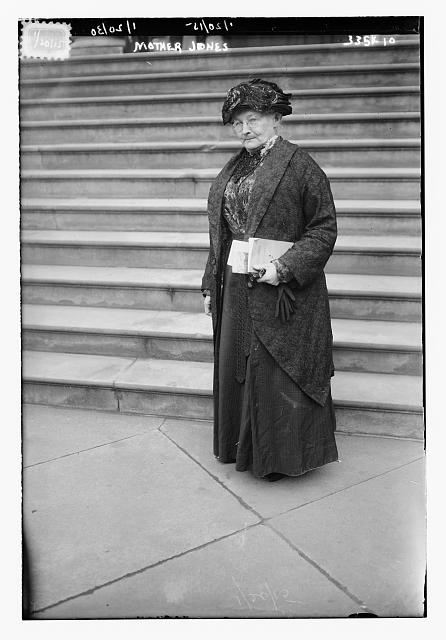Mary “Mother” Jones
b. 1830, Cork, Ireland; d. 1930, Silver Spring, Maryland
“In spite of oppressors, in spite of false leaders the cause of the workers continues onward. Slowly his hours are shortened, slowly his standards of living rise to include some of the good and beautiful things in life. Slowly, those who create the wealth of the world are permitted to share it. The future is in labor’s strong, rough hands.”
—Mary Mother Jones, Autobiography, 149
Denounced in the U.S. Congress as the “grandmother of all agitators,” Mary “Mother” Jones rallied legions of workers with a fiery rhetorical style belied by her staid appearance. She was drawn into labor activism by a series of personal tragedies—the death of her husband and four children in a yellow fever epidemic in 1867 and the destruction of all her worldly goods in the great Chicago fire of 1871. Turning to the Knights of Labor for assistance, she was impressed by their solidarity and thereafter became a central figure in the industrial wars of the late nineteenth century and well into the twentieth. Jones was a founding member of the Industrial Workers of the World in 1905, organized labor strikes, and toured the country as a lecturer for the Socialist Party of America. In 1913, at the age of eighty-four, she was sentenced to twenty years in prison for her role in the Paint Creek–Cabin Creek strikes in the West Virginia coalfields. Her conviction created a national uproar and she was soon released. Ten years later, now ninety-three years old, she was still organizing miners in West Virginia. In 1925, she published The Autobiography of Mother Jones.

Unknown artist. President Calvin Coolidge and “Mother” Jones standing outdoors, 1924. Library of Congress, Prints and Photographs Division, Washington, D.C.

Unknown artist. Mother Jones, n.d. Library of Congress, Prints and Photographs Division, Washington, D.C.
Related Place Setting
Related Heritage Floor Entries
- Jane Addams
- Inesse Armand
- Sylvia Ashton-Warner
- Angelica Balbanoff
- Catherine Beecher
- Ruth Benedict
- Yekaterina Breshkovskaya
- Rachel Carson
- Dorothea Dix
- Vera Figner
- Elizabeth Gurley Flynn
- Elizabeth Fry
- Emma Goldman
- Dolores Ibarruri
- Rachel Katznelson
- Helen Keller
- Aleksandra Kollantay
- Nadezhda Krupskaya
- Rosa Luxemburg
- Margaret Mead
- Golda Meir
- Louise Michel
- Katti Moeler
- Maria Montessori
- Federica Montseny
- Emma Paterson
- Frances Perkins
- Sofia Perovskaya
- Gabrielle Petit
- Jeannette Rankin
- Ellen Richards
- Eleanor Roosevelt
- Augustina Saragossa
- Hannah Senesh
- Marie Stopes
- Henrietta Szold
- Beatrice Webb
- Vera Zasulich
- Clara Zetkin